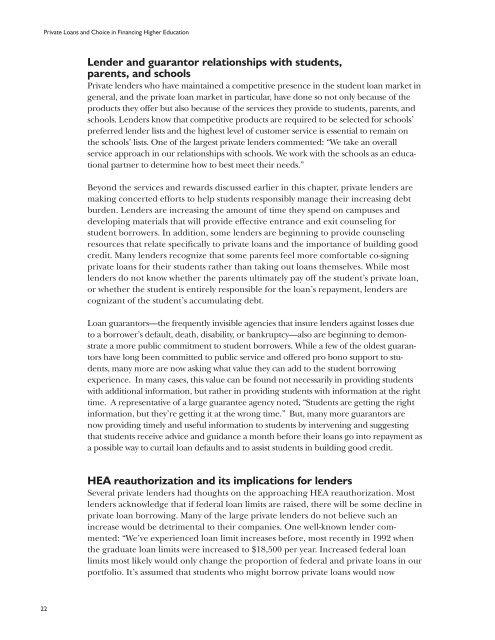Private Loans and Choice in Financing Higher Education - College ...
Private Loans and Choice in Financing Higher Education - College ...
Private Loans and Choice in Financing Higher Education - College ...
You also want an ePaper? Increase the reach of your titles
YUMPU automatically turns print PDFs into web optimized ePapers that Google loves.
<strong>Private</strong> <strong>Loans</strong> <strong>and</strong> <strong>Choice</strong> <strong>in</strong> F<strong>in</strong>anc<strong>in</strong>g <strong>Higher</strong> <strong>Education</strong>Lender <strong>and</strong> guarantor relationships with students,parents, <strong>and</strong> schools<strong>Private</strong> lenders who have ma<strong>in</strong>ta<strong>in</strong>ed a competitive presence <strong>in</strong> the student loan market <strong>in</strong>general, <strong>and</strong> the private loan market <strong>in</strong> particular, have done so not only because of theproducts they offer but also because of the services they provide to students, parents, <strong>and</strong>schools. Lenders know that competitive products are required to be selected for schools’preferred lender lists <strong>and</strong> the highest level of customer service is essential to rema<strong>in</strong> onthe schools’ lists. One of the largest private lenders commented: “We take an overallservice approach <strong>in</strong> our relationships with schools. We work with the schools as an educationalpartner to determ<strong>in</strong>e how to best meet their needs.”Beyond the services <strong>and</strong> rewards discussed earlier <strong>in</strong> this chapter, private lenders aremak<strong>in</strong>g concerted efforts to help students responsibly manage their <strong>in</strong>creas<strong>in</strong>g debtburden. Lenders are <strong>in</strong>creas<strong>in</strong>g the amount of time they spend on campuses <strong>and</strong>develop<strong>in</strong>g materials that will provide effective entrance <strong>and</strong> exit counsel<strong>in</strong>g forstudent borrowers. In addition, some lenders are beg<strong>in</strong>n<strong>in</strong>g to provide counsel<strong>in</strong>gresources that relate specifically to private loans <strong>and</strong> the importance of build<strong>in</strong>g goodcredit. Many lenders recognize that some parents feel more comfortable co-sign<strong>in</strong>gprivate loans for their students rather than tak<strong>in</strong>g out loans themselves. While mostlenders do not know whether the parents ultimately pay off the student’s private loan,or whether the student is entirely responsible for the loan’s repayment, lenders arecognizant of the student’s accumulat<strong>in</strong>g debt.Loan guarantors—the frequently <strong>in</strong>visible agencies that <strong>in</strong>sure lenders aga<strong>in</strong>st losses dueto a borrower’s default, death, disability, or bankruptcy—also are beg<strong>in</strong>n<strong>in</strong>g to demonstratea more public commitment to student borrowers. While a few of the oldest guarantorshave long been committed to public service <strong>and</strong> offered pro bono support to students,many more are now ask<strong>in</strong>g what value they can add to the student borrow<strong>in</strong>gexperience. In many cases, this value can be found not necessarily <strong>in</strong> provid<strong>in</strong>g studentswith additional <strong>in</strong>formation, but rather <strong>in</strong> provid<strong>in</strong>g students with <strong>in</strong>formation at the righttime. A representative of a large guarantee agency noted, “Students are gett<strong>in</strong>g the right<strong>in</strong>formation, but they’re gett<strong>in</strong>g it at the wrong time.” But, many more guarantors arenow provid<strong>in</strong>g timely <strong>and</strong> useful <strong>in</strong>formation to students by <strong>in</strong>terven<strong>in</strong>g <strong>and</strong> suggest<strong>in</strong>gthat students receive advice <strong>and</strong> guidance a month before their loans go <strong>in</strong>to repayment asa possible way to curtail loan defaults <strong>and</strong> to assist students <strong>in</strong> build<strong>in</strong>g good credit.HEA reauthorization <strong>and</strong> its implications for lendersSeveral private lenders had thoughts on the approach<strong>in</strong>g HEA reauthorization. Mostlenders acknowledge that if federal loan limits are raised, there will be some decl<strong>in</strong>e <strong>in</strong>private loan borrow<strong>in</strong>g. Many of the large private lenders do not believe such an<strong>in</strong>crease would be detrimental to their companies. One well-known lender commented:“We’ve experienced loan limit <strong>in</strong>creases before, most recently <strong>in</strong> 1992 whenthe graduate loan limits were <strong>in</strong>creased to $18,500 per year. Increased federal loanlimits most likely would only change the proportion of federal <strong>and</strong> private loans <strong>in</strong> ourportfolio. It’s assumed that students who might borrow private loans would now22
















